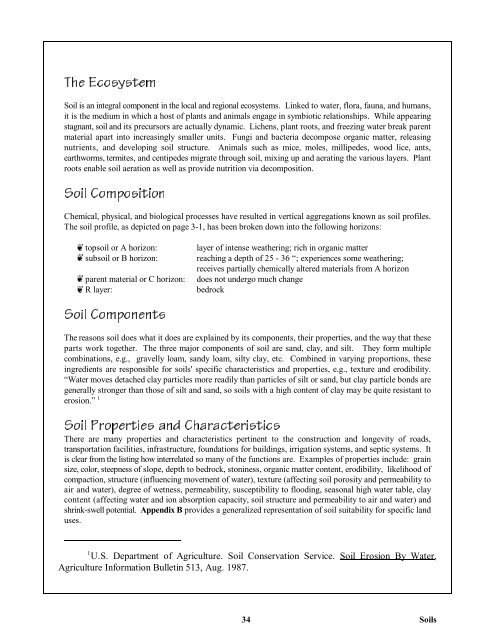A Natural Resource Management Guide for the County of Morris A ...
A Natural Resource Management Guide for the County of Morris A ...
A Natural Resource Management Guide for the County of Morris A ...
You also want an ePaper? Increase the reach of your titles
YUMPU automatically turns print PDFs into web optimized ePapers that Google loves.
The Ecosystem<br />
Soil is an integral component in <strong>the</strong> local and regional ecosystems. Linked to water, flora, fauna, and humans,<br />
it is <strong>the</strong> medium in which a host <strong>of</strong> plants and animals engage in symbiotic relationships. While appearing<br />
stagnant, soil and its precursors are actually dynamic. Lichens, plant roots, and freezing water break parent<br />
material apart into increasingly smaller units. Fungi and bacteria decompose organic matter, releasing<br />
nutrients, and developing soil structure. Animals such as mice, moles, millipedes, wood lice, ants,<br />
earthworms, termites, and centipedes migrate through soil, mixing up and aerating <strong>the</strong> various layers. Plant<br />
roots enable soil aeration as well as provide nutrition via decomposition.<br />
Soil Composition<br />
Chemical, physical, and biological processes have resulted in vertical aggregations known as soil pr<strong>of</strong>iles.<br />
The soil pr<strong>of</strong>ile, as depicted on page 3-1, has been broken down into <strong>the</strong> following horizons:<br />
topsoil or A horizon:<br />
È<br />
subsoil or B horizon:<br />
È<br />
parent material or C horizon:<br />
È<br />
R layer: È<br />
layer <strong>of</strong> intense wea<strong>the</strong>ring; rich in organic matter<br />
reaching a depth <strong>of</strong> 25 - 36 “; experiences some wea<strong>the</strong>ring;<br />
receives partially chemically altered materials from A horizon<br />
does not undergo much change<br />
bedrock<br />
Soil Components<br />
The reasons soil does what it does are explained by its components, <strong>the</strong>ir properties, and <strong>the</strong> way that <strong>the</strong>se<br />
parts work toge<strong>the</strong>r. The three major components <strong>of</strong> soil are sand, clay, and silt. They <strong>for</strong>m multiple<br />
combinations, e.g., gravelly loam, sandy loam, silty clay, etc. Combined in varying proportions, <strong>the</strong>se<br />
ingredients are responsible <strong>for</strong> soils' specific characteristics and properties, e.g., texture and erodibility.<br />
“Water moves detached clay particles more readily than particles <strong>of</strong> silt or sand, but clay particle bonds are<br />
generally stronger than those <strong>of</strong> silt and sand, so soils with a high content <strong>of</strong> clay may be quite resistant to<br />
erosion.” 1<br />
Soil Properties and Characteristics<br />
There are many properties and characteristics pertinent to <strong>the</strong> construction and longevity <strong>of</strong> roads,<br />
transportation facilities, infrastructure, foundations <strong>for</strong> buildings, irrigation systems, and septic systems. It<br />
is clear from <strong>the</strong> listing how interrelated so many <strong>of</strong> <strong>the</strong> functions are. Examples <strong>of</strong> properties include: grain<br />
size, color, steepness <strong>of</strong> slope, depth to bedrock, stoniness, organic matter content, erodibility, likelihood <strong>of</strong><br />
compaction, structure (influencing movement <strong>of</strong> water), texture (affecting soil porosity and permeability to<br />
air and water), degree <strong>of</strong> wetness, permeability, susceptibility to flooding, seasonal high water table, clay<br />
content (affecting water and ion absorption capacity, soil structure and permeability to air and water) and<br />
shrink-swell potential. Appendix B provides a generalized representation <strong>of</strong> soil suitability <strong>for</strong> specific land<br />
uses.<br />
1 U.S. Department <strong>of</strong> Agriculture. Soil Conservation Service. Soil Erosion By Water,<br />
Agriculture In<strong>for</strong>mation Bulletin 513, Aug. 1987.<br />
34<br />
Soils


